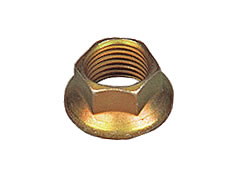
Do you know the difference between flange nuts and plain hex nuts? Like all nuts, they are threaded fasteners that are used in conjunction with a bolt. You can twist a nut onto the end of a bolt to prevent it from loosening. The nut will secure the bolt in place while simultaneously holding the parts with which the bolt is used together.
While most nuts feature a hexagonal shape, they are available in different styles. There are plain hex nuts, for instance, and there are flange nuts.
What Are Plain Hex Nuts?
Plain hex nuts are traditional, hexagonal-shaped nuts. They are characterized by a hexagonal shape consisting of six uniform sides of equal length.
You can install plain hex nuts using a wrench. With six uniform sides, they support a hex socket wrench. After placing the hex socket wrench over a plain hex nut, you can turn it clockwise to tighten the nut or counterclockwise to loosen the nut.
What Are Flange Nuts?
Flange nuts are threaded nuts with a protruding rim. As shown in the photo above, they feature a circular rim.
Flange nuts still have a hexagonal shape — but only a single side. One side of a flange nut is hexagonal, whereas the other side features the circular rim.
Differences Between Plain Hex Nuts and Flange Nuts
Plain hex nuts and flange nuts aren’t the same. Plain hex nuts are, by far, the most common type of nut. They offer a versatile and simple fastening solution. Flange nuts, while not as common, offer an alternative fastening solution.
Flange nuts differ from plain hex nuts with their flanged design. They are flanged in the sense that they have a protruding rim. What’s the purpose of this protruding rim exactly?
The protruding rim on flanged nuts works like a built-in washer. Washers are designed to distribute the load of a threaded fastener. They spread the fastener’s load over a larger surface area, which in turn protects the fastened parts from damage. You can always place a separate washer on a bolt, but another option is to use a flange nut.
Flange nuts eliminate the need for a separate washer. You won’t have to install a separate washer when using them because the protruding rim performs the same task. The protruding rim will distribute the fastener’s load over a larger surface area — just like a separate washer will.



